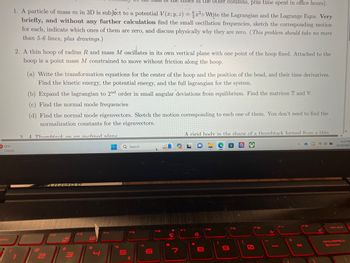Question
Question 1.

Transcribed Image Text:**Course Module: Advanced Mechanics Problems**
---
### Problem Set
#### 1. Particle in a Potential Field
A particle of mass \( m \) in 3D is subject to a potential \( V(x, y, z) = \frac{k}{2} x^2 e^{\lambda z} \).
- **Task:** Write the Lagrangian and derive the Lagrange equations. Briefly, and without any further calculation, determine the small oscillation frequencies. Sketch the corresponding motion for each mode, indicating which are zero, and discuss the physical reasons for these results. *(Limit your explanation to 5-6 lines and include relevant sketches.)*
#### 2. Dynamics of a Thin Hoop with a Bead
A thin hoop of radius \( R \) and mass \( M \) oscillates in its vertical plane with one point fixed. A point mass \( M \) is attached, constrained to move frictionlessly along the hoop.
- **Tasks:**
- (a) Write the transformation equations for the center of the hoop and bead position, including time derivatives. Derive the kinetic energy, potential energy, and complete the Lagrangian for the system.
- (b) Expand the Lagrangian to the second order in terms of small angular deviations from equilibrium. Identify and express matrices \( T \) and \( V \).
- (c) Determine the normal mode frequencies.
- (d) Compute the normal mode eigenvectors. Sketch the motion corresponding to each one. Ignore normalization constants.
#### 3. Thumbtack on an Inclined Plane
- **Problem Context and Tasks not visible in the current text.**
*(Note: Please refer to course materials or mathematical software for detailed derivations and validations of the theoretical content in these problems.)*
---
**Graphical and Diagrammatic Explanations**
*Section to describe any associated diagrams of the problems if presented. Please request instructor-provided diagrams for visual aids.*
---
Expert Solution
This question has been solved!
Explore an expertly crafted, step-by-step solution for a thorough understanding of key concepts.
Step by stepSolved in 3 steps with 4 images

Knowledge Booster